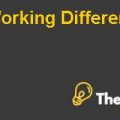
Lyondell Basell Option for Bankruptcy:
ANS:
The Chapter 11 is used for the purpose of bankruptcy. Lyondell Basell has no choice because of its debts and lower demand for its products in the chemical industry. Customers were reducing their demand as they were reducing their inventory cost due to the financial crises in the year 2008; which ultimately reduced the market demand for chemicals. Lyondell Basell was unable to pay its debts and company’s creditors wanted to ensure that their investments were paid-off. The only viable option for Lyondell Basell was to place its US operations and German subsidiary operations under Chapter of 11 Bankruptcy protection.
This option was viable because when a company was heavily in debt and couldn’t generate profit from operations to pay-off its debt, by Law a company can file a petition for Bankruptcy or it is forced to file a petition for bankruptcy in order to pay-off creditors’ debts. For bankruptcy the following codes prevail in the U.S. by Law.
Chapter 7 of Bankruptcy: Chapter 7 of Bankruptcy is defined as the dissolution of the business operations. Under this code, bankrupted companies pay-off its debts by selling off its assets. In this case, Lyondell Basell was based on going concern principle; thus this option was not viable for the company.
Chapter 13 of Bankruptcy: Chapter 13 of Bankruptcy also defines paying-off the creditor’s debts, but this has limitations. The limitations are defined that only individual who earns stable income. For the companies like Lyondell Basell, this option of bankruptcy is not exercisable. Thus, this wasn’t the viable option for Lyondell to proceed with. Chapter 11 Protection only for subset of the company:
ANS:
The organization seeks only for the subset of the organization because it has indirect influence on its subsidiaries (Lyondell and Basell) from its consolidated company. The analysis of discounted cash flows valuation shows the net present value which is $18,732 million. From comparable multiple analysis given in the case of Exhibit 14B, it can also be concluded that these comparable are more realistic and are showing positive results against the industry averages and also with its competitors multiples.
Approval for Debtors in Possessions financing:
ANS:
Lyondell Basell superior management had realistic thoughts, that from DIP financing: Chapter 11 was viable for the survival of the company. Through this filling of bankruptcy, debts would be paid-off from the restructuring of operations. The judgment placed by the judge, if it ruled in favor of unsecured creditors then the restructuring of the operations and financing would be in benefit and all the creditors would get their part of investment in near future and company would survive as it is the last resort option. From the analysis of the discounted cash flows, secured creditors would also be satisfied from it as it shows the incremental future cash flows. These incremental future cash flows show that all the payments would be made from the profit generated from the sale of products. Please refer the excel sheet for the calculation of discounted cash flows valuation of the firm.
Pros and Cons of DIP Financing:
The benefits of Chapter 11 of Bankruptcy is that the debtor can continue its business operations as it was doing previously but debtor could not make major decision without consent of the court concerned or the appointed trustee from the court. On the other side, it also allows the restructuring of the debts by asking its creditors. It certain the employee’s job, ensures that the investment portion of stake holders would continue to exist and forces the company to re-evaluate its plan for operations and financial position.
The management that was part of company before filling of Chapter 11 bankruptcies in court would be left intact from liquidation and these management associate would also be a part of restructuring; this would cause problems in the future. The Chapter 11 also provides the business an excessive competitive advantage in the market, where it changes the economic direction of the industry. It also weakened the collateral value and also increased associated risk of secured loans.....................
This is just a sample partial case solution. Please place the order on the website to order your own originally done case solution.
The recession hit the industry and the global financial crisis of 2008, in January 2009, LyondellBasell Industries AF SCA, one of the leading international diversified chemical companies in the world with headquarters in the Netherlands, placed its U.S. operations and a German subsidiary to the U.S. Chapter 11 bankruptcy. In order to successfully reorganize the business for the foreseeable future, the company aims to raise more than $ 8 billion in super-priority "debtor-in-possession (DIP)" loan from a group of thirteen financial institutions, including commercial banks, investment banks, hedge funds and private equity funds . Representing one of the largest in the history of DIP loans, this financing is considered critical to the survival of the company. One of the unique and controversial features of funding was $ 3.25 billion 'Roll-Up "facility, whereby the number of pre-bankruptcy creditors of Lyondell were allowed to increase the priority of debt they were required (so they're ahead of all other pre-bankruptcy debts of the company ), provided that the lenders proposed new loans to companies to help finance its restructuring. costly liquidation as an alternative, different groups of creditors objected to the financing package DIP, putting reorganization Lyondell, and survival as a going concern, the considerable risk. "Hide
by Stuart C. Gilson, Sarah L. Abbott Source: Harvard Business School 29 pages. Publication Date: December 21, 2009. Prod. #: 210001-PDF-ENG












